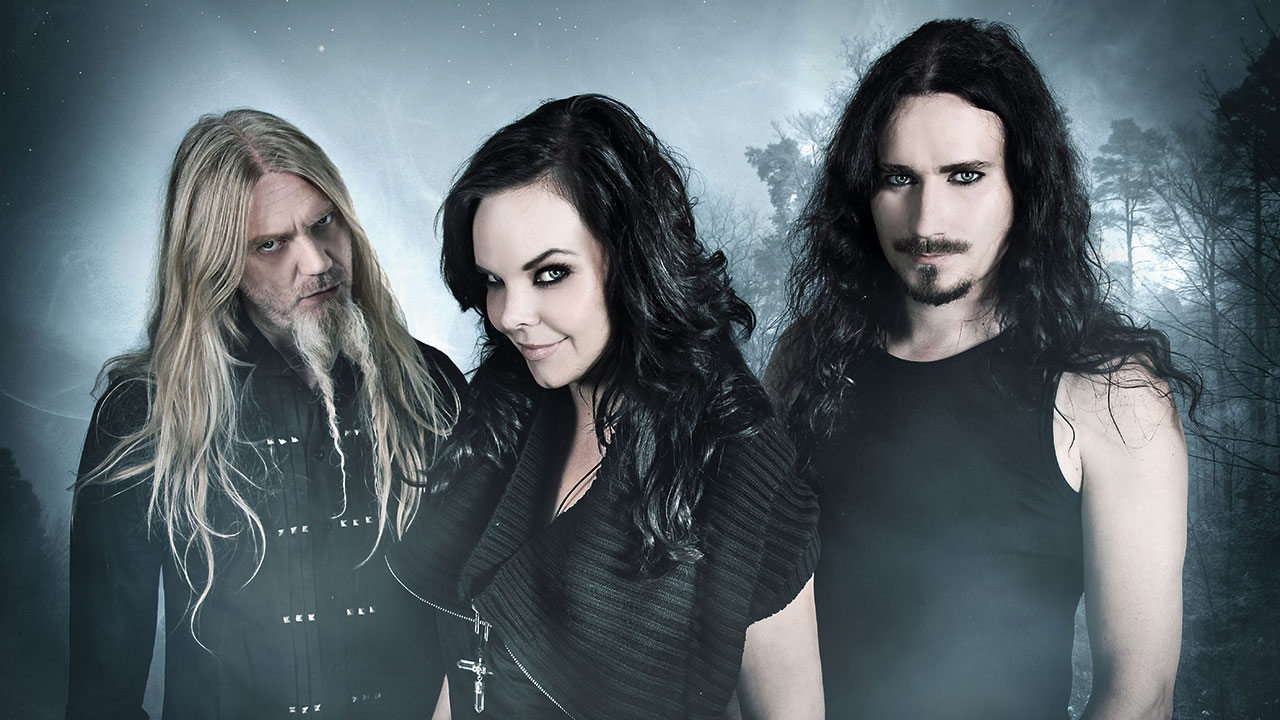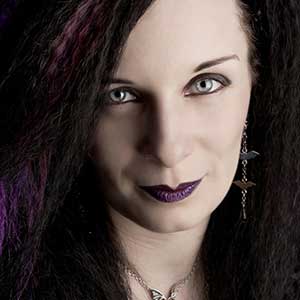The story of Nightwish's Imaginaerum
How Finnish symphonic prog metallers Nightwish created their bold 2011 concept album Imaginaerum

A milky white moon illuminates the black velvet sky and shines down on the snow-tipped fairground below. Here, there are rides beyond your wildest dreams – a rollercoaster that reaches the stars, a Ferris wheel with an awe-inspiring view and airships that fly to the furthest corners of the galaxy. Over the bleak yet inviting ground hangs a sign with gold lettering that glitters in the moonlight. It reads simply: “Imaginaerum”.
“It’s a metaphor for life,” explains Nightwish’s Tuomas Holopainen as he traces the swirls of the fantastical pleasure ground that graces his band’s new album cover. Tomorrow, the Finnish composer and keyboardist will travel to Canada to begin the next stage of this magickal journey but today he chats freely at London’s Angel Studios, where part of the album was recorded.
The story of Imaginaerum begins in the summer of 2007, as the dust settled on the band’s sixth studio release Dark Passion Play. “I was listening to the final master and wondering what we could do next because it was so ridiculously big, diverse and bombastic,” Holopainen recalls. “I remember the moment vividly when I had this vision… let’s do a movie of each of the songs and release it as a double CD.”
He explained his idea to director Stobe Harju, who had created the video for the band’s single The Islander. Harju’s reaction was amazement but he agreed to helm the project on the condition it was released as a separate full-length movie with a proper storyline and real actors. Holopainen agreed and work began on a script to accompany his dramatic visions.
While Harju concentrated on the visual side, it was up to Tuomas Holopainen to keep the musical flame burning brightly. He began writing as Nightwish embarked on what became a two-year tour but as the shows progressed, word started to spread about whether recently-recruited vocalist Anette Olzon was really up to the job. She seemed to distance herself from the rest of the band on stage and there were rumours she was working on a solo album. Was all really well in Camp Nightwish or was there a sense of disharmony? Holopainen screws up his face: “Not disharmony – that’s the wrong word. Everyone was feeling really good and the chemistry was there but everybody was just dead tired. The big mistake we made was to book such a long and intense tour with a new singer... it was just a bit too much. Everybody was worrying about Anette, she was worrying about herself and there were a lot of other things. People started cracking up…” he looks away and laughs nervously but refuses to elaborate. After a pause, he continues: “When the tour finished everybody was happy but we just needed some time out. Not necessarily from each other, just time out from music and travelling.”
As the rest of the band put down their instruments and relaxed, Holopainen jumped on a plane and headed out to the Australian outback with three close friends. As they travelled across the desert and slept under the stars, the musician found the inspiration he needed for Imaginaerum.

A few months later, Nightwish regrouped in Finland to begin recording demos and as the leaves on the trees turned from luscious green to a beautiful umber, the first few tracks started to take shape. Last February, Holopainen flew over to London to meet up with the renowned Pip Williams and begin the symphonic arrangements. A section of the London Symphony Orchestra, referred to as the Looking Glass Orchestra, provided the instrumentation while a choir of young musicians contributed the eerie vocal harmonies that Holopainen was after.
Sign up below to get the latest from Prog, plus exclusive special offers, direct to your inbox!
With the first signs of spring bursting through the snow, it was back to his homeland for more recording, this time at Petrax studios situated in the Finnish countryside. It was here that Troy Donockley, formerly of prog-rockers Iona and The Enid, also revived his role with his trademark uilleann pipes as well as low whistles, bouzouki, bodhrans and backing vocals. “We all love the sound of Celtic instruments – they’re just magical and fit the ideology of Nightwish really well. Troy interpreted our ideas and [since Dark Passion Play] has become such a close personal friend, he’s like the sixth member!” Tuomas Holopainen laughs as he reveals the piper has already passed several initiation rites. “He keeps up with the drinking fantastically and he’s already 83 per cent Finn because he rolled in the snow naked a couple of years ago!” Holopainen adds with a mischievous glint in his eye. “But he must go into an icy lake in the winter to get his 100 per cent Finnish passport!”
The magickal musical dream of Imaginaerum was almost complete. In August of this year, Nightwish re-signed their record deal with Nuclear Blast, cementing the release of what will be their seventh studio album this December. Tuomas Holopainen leans back on a leather sofa and pours himself another glass of red wine as he ponders the journey he started almost three years ago. This modest and softly-spoken young man has created one of the most ambitious and diverse albums of Nightwish’s career. Take for example, the lounge-room styled Slow, Love, Slow – a song that brings the musician back to his jazz studies and really shows off Anette Olzon’s voice. It begs the question of whether the singer had any training in between albums. Tuomas Holopainen shakes his head: “When she sang on Dark Passion Play, we had known each other for about two months. This time, she had the space to rehearse the songs, she knew us and she felt so much more confident.” He adds: “She had a lot of weight on her shoulders when she joined but now I know her scale, her strengths and her weaknesses it was easier to write the songs. I know how to push her and I knew where to not go as well...”
Another song where Olzon seems to be making the most of her vocal freedom is the wonderfully over-the-top Scaretale, a twisted and flamboyant symphony of childhood nightmares influenced by US composer Danny Elfman. “I just felt we needed to be able to laugh at all the bad things,” he grins and explains the intro was inspired by the score of the horror film Hostel.
And with Holopainen in charge of 99 per cent of the writing – just one song, The Crow, The Owl And The Dove was written by growler and bassist Marco Hietala – he had free reign to really allow his visions to become a reality. Unsurprisingly, Imaginaerum also contains a lot of personal elements and none more so than the four-part Song Of Myself, which rests near the very end of album. “It’s the ultimate personal catharsis and I wanted to try a different approach of writing lyrics,” the composer explains of the unusual number. As the music twists and turns towards a climatic conclusion, it's illustrated with a lengthy poem narrated by a number of different voices. Opening with Troy Donockley’s distinctive tones, it also features spoken contributions from the band’s management, crew, close friends and family.
It’s already been a rollercoaster ride and Nightwish aren’t even near the top yet. Next year, they’ll embark on another world tour with an inaugural performance in LA at the end of January, supported by fellow Finns and labelmates Amorphis.
But there’s still one question that hasn’t been answered. What about the film that Holopainen so desperately wanted to accompany the album? He screws up his face and explains: “The whole thing went upside down but we finally have the finance for it so it’s going to be a separate release. I’m going to fly over to Montreal tomorrow morning and that will be the first time I’ll see all the set-ups, the props, the dresses, the actors – I have strong faith [in director Stobe Harju].” The storyline will match the album’s track listing and follow each theme with liberal interpretation. Versions of every song will be used in some shape or form as background music and Nightwish themselves will have cameo roles along with Magic Circle member Troy Donockley taking the part of a magician. Holopainen anticipates a ‘making of’ documentary will accompany a special tour edition of the album later next year.
“The moment I stop dreaming I will die,” Tuomas Holopainen confides seriously and takes another sip from his wine glass. “Dreaming is really what keeps you alive and I still have a bunch of dreams.” A live show with a full orchestra, the soundtrack to the Disney book The Life And Times Of Scrooge McDuck, the future Nightwish albums and lots of travelling are all on his ‘must do’ list.
“I love the diversity of life,” he says. “I like the change of moods, the four seasons, the different genres of music and bringing it all together – I really don’t have any expectations and I still write for myself; it’s the only way to keep everything honest.”
This article originally appeared in issue 21 of Prog Magazine.

Contributing to Prog since the very first issue, writer and broadcaster Natasha Scharf was the magazine’s News Editor before she took up her current role of Deputy Editor, and has interviewed some of the best-known acts in the progressive music world from ELP, Yes and Marillion to Nightwish, Dream Theater and TesseracT. Starting young, she set up her first music fanzine in the late 80s and became a regular contributor to local newspapers and magazines over the next decade. The 00s would see her running the dark music magazine, Meltdown, as well as contributing to Metal Hammer, Classic Rock, Terrorizer and Artrocker. Author of music subculture books The Art Of Gothic and Worldwide Gothic, she’s since written album sleeve notes for Cherry Red, and also co-wrote Tarja Turunen’s memoirs, Singing In My Blood. Beyond the written word, Natasha has spent several decades as a club DJ, spinning tunes at aftershow parties for Metallica, Motörhead and Nine Inch Nails. She’s currently the only member of the Prog team to have appeared on the magazine’s cover.
